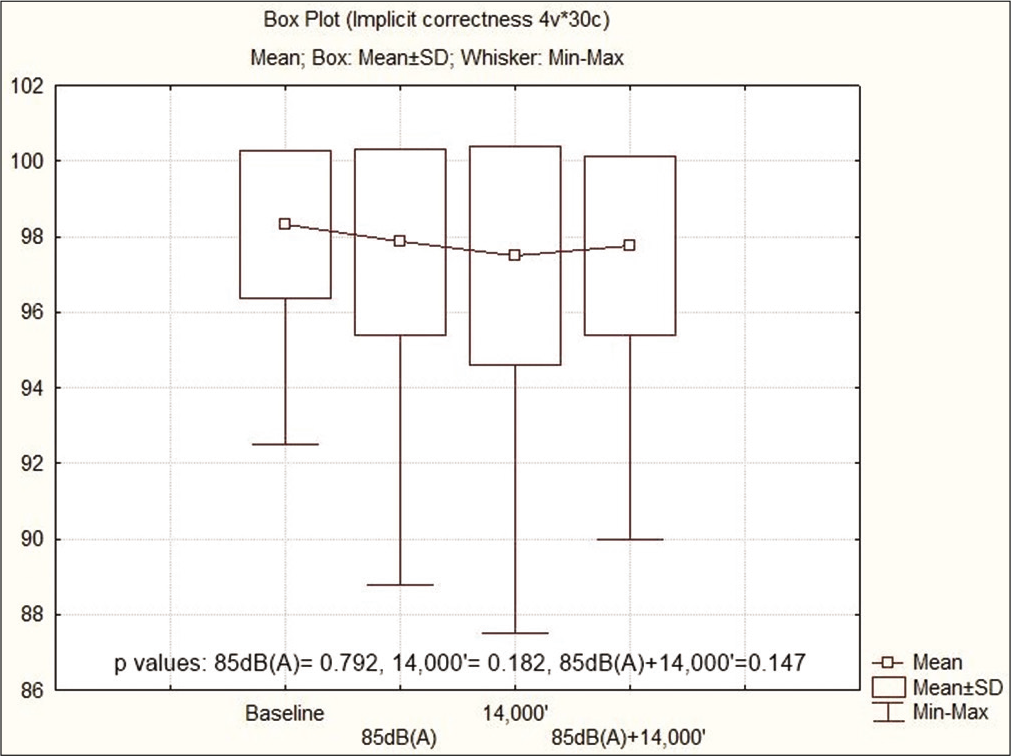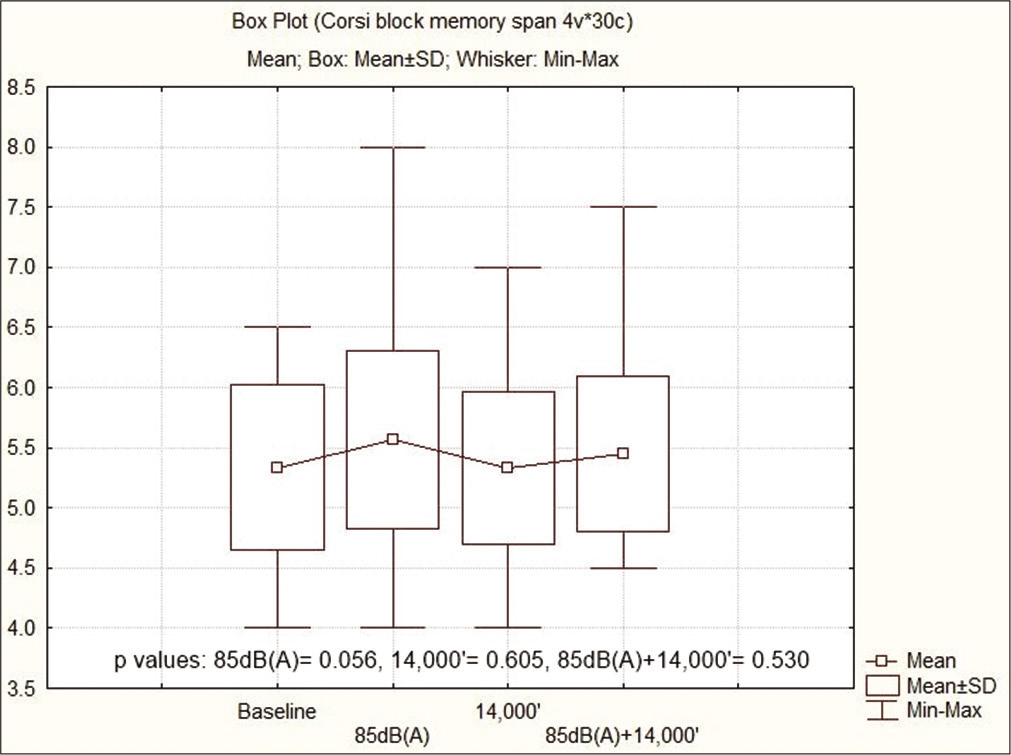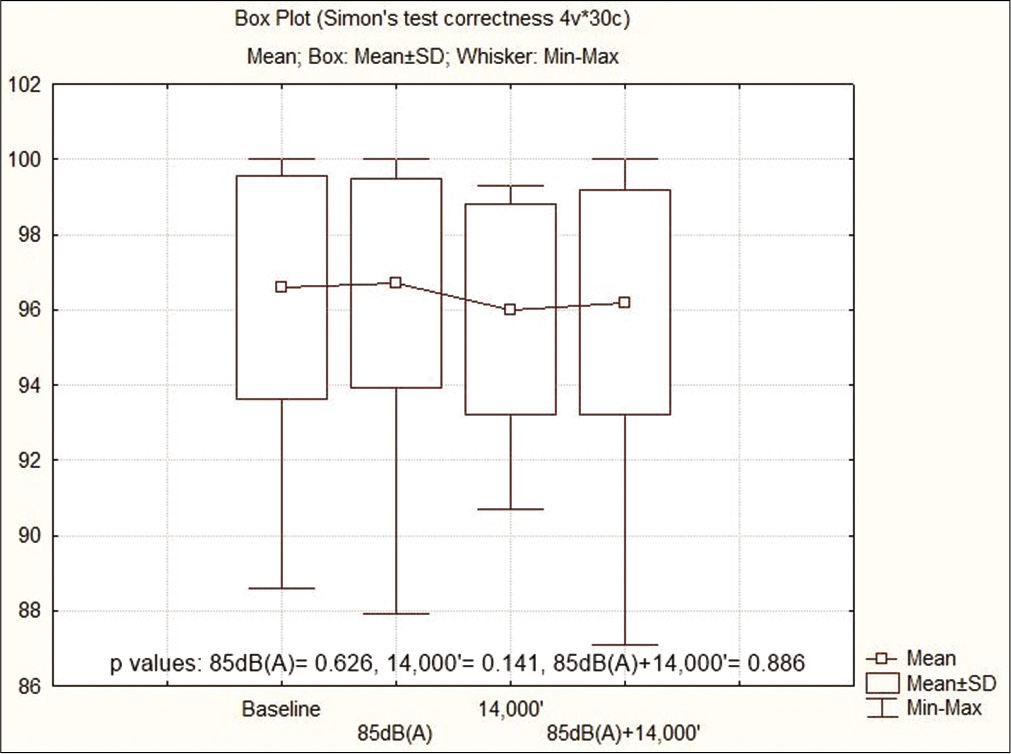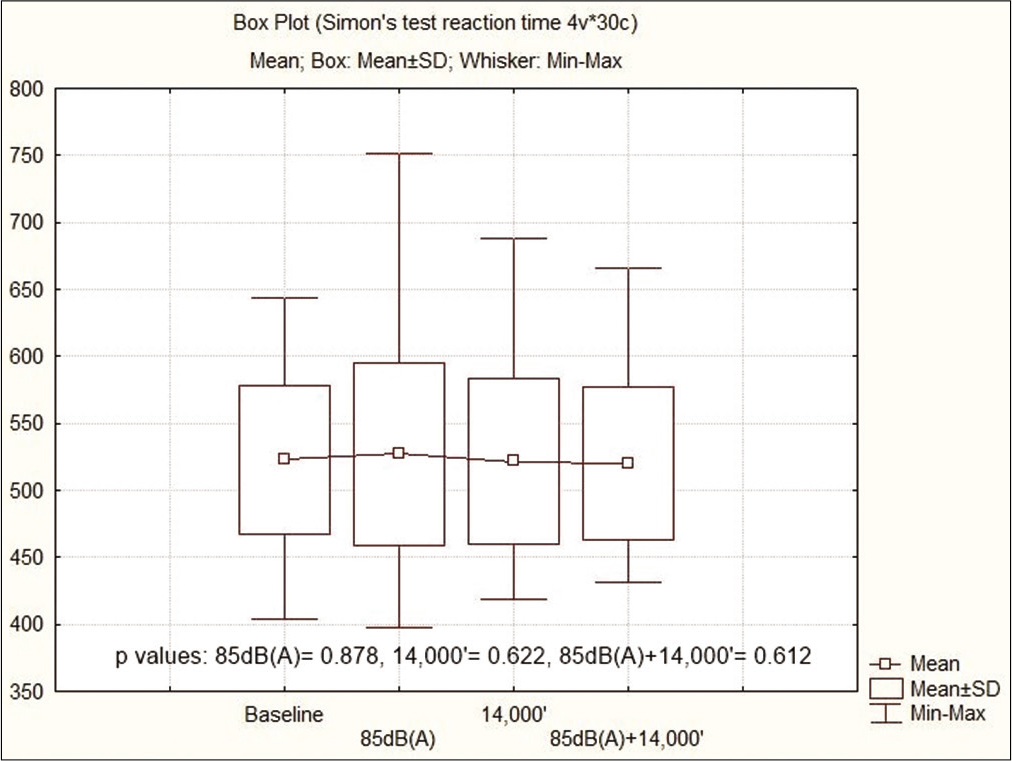Translate this page into:
Concurrent white noise and acute hypobaric hypoxia: Effect on aviation cognitive performance

*Corresponding author: Dr D Ghosh, MBBS, MD (Aerospace Medicine), Station Medicare Centre, AFS Thanjavur, Pudukottai Road, Thanjavur - 613 005, Tamil Nadu, India. dr.dvdpghosh@rediffmail.com
-
Received: ,
Accepted: ,
How to cite this article: Ghosh D, Gaur D, Sinha B, Aravindakshan B. Concurrent white noise and acute hypobaric hypoxia: Effect on aviation cognitive performance. Indian J Aerosp Med 2020;64(2):82-7.
Abstract
Introduction:
Optimal cognitive performance is the essence of effective execution of a flying mission. Effects of two commonly encountered aviation stressors, hypoxia and noise, on performance have been studied. However, studies on effects of concurrent dual effects of both these stressors on key cognitive parameters are sparse; hence, the objective was to examine these effects.
Material and Methods:
Cognitive performances were assessed among 30 healthy volunteers (28 males and 2 females) sequentially in four different conditions – baseline (without stressors), 85 dB(A) noise, 14,000 ft altitude, and concurrent exposure to 85 dB(A) noise at 14,000 ft altitude. White noise was simulated through software, altitude in the hypobaric chamber and cognitive performance was assessed with tests from Psychology Experiment Building Language (PEBL) test battery. Data were analyzed using descriptive statistics and repeated measures ANOVA.
Results:
The study revealed statistically significant direct detrimental effect of altitude and noise on implicit reaction time independently as well as concurrently. However, there was insignificant interaction effect between the dual stressors on implicit reaction time. There were no statistically significant effects of dual stressors on implicit correctness, visuospatial working memory, and selective attention. Although statistically not significant, noise enhanced the performance level in the form of increased Corsi block memory span and Corsi block total score.
Conclusion:
No significant effect of the dual stressors was observed on most of the cognitive parameters. However, implicit reaction time, a measure of pilot’s risk-taking behavior, was found to be significantly affected by the dual stressors. Further research with a larger sample of aircrew population who differ in age, experience, and other potentially influencing factors is recommended.
Keywords
Cognitive performance
Flight safety
Hypoxia
Noise
PEBL test battery
INTRODUCTION
Optimal cognitive performance is the essence of execution of a flying mission. Any deterioration in this aspect may lead to mission compromise and jeopardy of flight safety. Hence, it becomes necessary to study the effect of commonly encountered aviation stressors on key aviation cognitive skills. Two such known stressors are hypoxia and noise. It has been well documented in the literature that hypoxia impairs mental performance, psychomotor tasks, cognitive tasks, and special senses.[1] Similarly, effect of noise on performance has been well documented. Noise impairs both serial recall and mental arithmetic capability.[2] On the contrary, executive function in the form of attention accuracy improved in louder noise.[3] Verbal, visuospatial working memory, and cognitive flexibility (compound remote association task) were affected in the form of increased reaction time and reduced number of correct response.[4] While exposed to continuous loud noise (84 dB), there was diminution of Stroop and Garner effects (executive function).[5] Although there was no effect of noise on vigilance,[6] it has been brought out that noise impaired signal detection performance (vigilance) after 1.5 h of testing.[7] On the contrary, Gaur found intermittent background instrumental music presented at 10 dB(A) above the ambient noise level had a significant beneficial effect on visual vigilance.[8]
Existing literature on the concurrent effect of these dual stressors, namely, hypoxia and noise is sparse. Studies in the past[9,10] have not taken into consideration operationally relevant and realistic scenario. Key aspects of aviation cognitive performance domain are implicit association, selective attention, visuospatial working memory along with perceptual judgment, visual processing and inhibition. Hence, these aspects need to be examined while studying cognitive performance and the changes under aviation stressors. To the best of our knowledge, there has been no study conducted so far to assess these key cognitive parameters under dual stressors of acute hypobaric hypoxia and noise. Hence, the objective of the present study was to bring out the effect of aforesaid stressors both individually and concurrently on the aviation specific cognitive performance.
MATERIAL AND METHODS
Subjects
Thirty healthy volunteers (28 males and 2 females) with mean age of 28.7 years participated in the study. Exclusion criteria were history of smoking, acute mountain sickness, recent blood donation, anemia, chronic alcoholism, claustrophobia, colour blindness, presence of any ENT, cardiovascular or neurological disease, and physical limitations.
Materials
Hypobaric altitude chamber was used for exposure to simulated altitude. Passmark SoundCheck Ver 3 software was used to generate white noise through multimedia speaker system. 85 dB(A) white noise at bilateral pinna level was ensured. Multimedia speakers, a handheld, battery operated sound level meter with “A” weighting were used. Portable pulse oximeter and sphygmomanometer were used to record vital parameters.
Psychology Experiment Building Language (PEBL) version 0.14[11-13] was used for measuring executive cognitive functions.[14] PEBL is an open source software program using cross-platform Simple Direct Media Library (libSDL) and provides valid and versatile new research tools for assessing executive functions. PEBL Implicit Association task was used to assess implicit association.[11,15] It uses noncontroversial stimuli of natural kind, namely, living versus non-living. The volunteer has to press either “1” or “2” button to indicate a suitable response. PEBL Corsi Block task is used to assess visuospatial working memory.[11,14] The subject observes sequence of blocks lit up in the computer screen and then is required to repeat the sequence in order by clicking the boxes on the screen with the help of touchpad. The task starts with a small number of blocks (two blocks) that gradually increase in number, up to nine blocks according to the performance. The test measures both the number of correct sequences and the longest sequence remembered. PEBL Simon Interference task is used to assess perceptual judgment, visual processing, inhibition, and selective attention.[13,16] The subject has to judge and respond as quickly as possible with the appearance of “blue dot” and “red dot” by pressing right/left shift key accordingly. The dot may appear anywhere on the screen. A total of 140 situations in three sets are judged for analysis.
Experimental design and protocol
The study was design as a randomized, repeated measure, single-blinded, prospective, experimental study. An informed written consent was taken from each participant. The circadian bias was controlled by scheduling both hypoxia sessions for each group at the same time of the day (1400– 1700 h). On the day of experimentation, each participant was given multiple practice sessions on the PEBL tasks to get familiarized with the test batteries. This was followed by recording of the baseline values of the cognitive tasks. The tasks were then repeated following exposure to 85 dB (A) noise. Each participant was then exposed to 14,000 ft altitude in the hypobaric altitude chamber. The tasks were repeated at this altitude to study the effects of hypoxia. This was followed by exposure of the participants to 85 dB(A) noise at 14,000 ft and tasks were repeated to study the combined effects of noise 85 dB(A)–14,000 ft altitude. Along with the cognitive functions assessment, blood pressure, heart rate, and SpO2 were also monitored.
Statistical analysis
Descriptive analysis, one-way repeated measures ANOVA, and Tukey HSD post hoc comparison tests were done for analysis of data. Confidence intervals were calculated at 95% confidence level and the level of significance was set at P < 0.05. The independent variables were 85 dB(A) noise, 14,000 ft altitude, and combined 85 dB(A)–14,000 ft altitude. The dependent variables were “Implicit reaction time,” “Implicit correctness,” “Corsi block memory span,” “Corsi block total score,” “Simon’s correctness,” “Simon’s reaction time,” “Heart rate,” “Oxygen saturation,” “Systolic blood pressure,” “Diastolic blood pressure,” “Mean arterial pressure,” and “Pulse pressure.”
RESULTS
The mean age of 30 healthy volunteers was 28.7 ± 4.4 years. The measures of dependent variables are presented in Table 1. Box-whisker plot depicting implicit reaction time (millisecond), implicit correctness (%), Corsi block memory span (span score value), Corsi block total score (block score value), Simon’s correctness (%), and Simon’s reaction time (millisecond) in test conditions are shown in sequence [Figures 1-6].
| Dependent variables | Baseline | 85 dB(A) noise | 14,000 ft altitude | 14,000 ft+85 dB(A) |
|---|---|---|---|---|
| Implicit reaction time (millisecond) | 678.3±67.90 | 653.3±72.04 | 646.8±66.07 | 631.0±69.00 |
| Implicit correctness (%) | 98.3±1.95 | 97.9±2.45 | 97.5±2.89 | 97.8±2.36 |
| Corsi block memory span (span score value) | 5.3±0.70 | 5.6±0.75 | 5.3±0.64 | 5.5±0.66 |
| Corsi block total score (block score value) | 53.5±18.51 | 60.55±20.67 | 53.3±15.42 | 55.8±16.7 |
| Simon test correctness (%) | 96.6±3.03 | 96.6±2.79 | 96±2.85 | 96.1±3.01 |
| Simon test reaction time (millisecond) | 522.7±56.13 | 526.5±69.78 | 521.9±63.33 | 520.2±58.02 |

- Mean ± SD of Implicit reaction time.

- Mean ± SD of Implicit correctness.

- Mean ± SD of Corsi block memory span.

- Mean ± SD of Corsi block total score.

- Mean ± SD of Simon’s correctness.

- Mean ± SD of Simon’s reaction time.
Repeated measures ANOVA showed statistically significant direct detrimental effect of altitude (F = 7.944, P = 0.008) and noise (F = 14.665, P = 0.0006) on implicit reaction time. Similarly, combined application of noise and altitude also significantly affected the implicit reaction time (P = 0.0001). However, there was insignificant interaction between the effect of the independent variables, namely, altitude and noise on implicit reaction time (P > 0.05). Within-subject repeated measures ANOVA showed insignificant effect of altitude (F = 1.86, P = 0.182) and noise (F = 0.07, P = 0.792) on implicit reaction correctness. rANOVA and post hoc analysis did not show any significant direct or interaction effect of the stressors on the four dependent variables. Although statistically insignificant, noise enhanced the performance level in the form of increased Corsi block memory span and Corsi block total score [Figures 3-4].
DISCUSSION
The present study intended to examine the combined effect of hypoxia and noise on aviation cognitive performance. The study altitude was selected at 14,000 ft based on the fact that Federal Aviation Regulation (FAR–91.211) mandates flying without supplemental oxygen at 14,000 ft for a maximum duration of 30 minutes. The study altitude lies in the “Stage of compensation” where any additive effect of stressors like noise on performance may be easily evident. White noise is a random signal with a constant power spectral density and has been used to maintain reproducibility in an operationally relevant environment. Cockpit noise level in fighter aircraft ranges from 85.5 to 103.2 dB(A).[17] Acceptable levels of noise in cockpit as prescribed by Defense Safety Oversight Council (DSOC) USA is 85 dB(A) for 8 h in a day. According to AFOSH STD 48-20, 85 dB(A) noise level is allowed at ear level with the use of single noise attenuating device[18]. Hence, white noise of 85 dB(A) was chosen as the exposure limit at the ear level in the present study.
In this study, a statistically significant (P < 0.05) decrement was found in implicit reaction time (IAT) due to both hypoxia and noise. This is considered important in the context that implicit association measures attitude and belief that people may be unwilling or unable to report. It augments pilot’s risk-taking behavior that may lead to hazardous consequences in high-risk situations. The IAT is thought to measure implicit attitudes – introspectively unidentified traces of past experience that mediate favorable or unfavorable feeling, thought, or action toward social objects.[19] “IAT effect” represents the reaction time difference between the two IAT conditions when the mean reaction time in the stressed condition is subtracted from the mean reaction time in the safe condition. A larger IAT effect corresponds to a greater preference for risky behavior.[20]
Although decreased, changes of implicit correctness were not statistically significant. The change of implicit association findings in the form of reaction time and correctness may possibly be explained with “Maximum adaptability” theory.[21] Studies have found contradictory effect of noise on selective attention from the extent of “degraded performance” to “no effect.”[22,23] Statistically insignificant effect of noise on selective attention supports existing literature.[23] The present experiment did not show any significant changes in “selective attention” at 14,000 ft altitude exposure or with concurrent exposure to white noise of 85 dB(A). Although insignificant, noise enhanced the performance level in the form of increased Corsi block memory span and Corsi block total score, supporting the existing literature.[24] However, likely improvement in performance due to arousal effect of noise may have been masked by the effect of hypoxia, which is known to degrade cognitive function.
The previous studies have shown negligible effect on psychomotor task in the presence of 85 dB noise at 8000 ft and 6.5 hours duration exposure.[25,26] The study altitude (8000 ft) was unlikely to exert any significant neurological effect. Sharma[9] did not find any decrement in vigilance tasks in his subjects when exposed to hypobaric hypoxia at 12,000 ft of simulated altitude, with the presence of dual stressors noise and hypoxia. However, in that study, only one vigilance task (split ring orientation task) was used. In another study, simultaneous exposure of normobaric hypoxia, noise, and vibration exerted significant effects on perceptual speed, vigilance, and discrimination at 19,000 ft.[10] The study was conducted using different gas mixture to simulate desired altitude (normobaric hypoxia). Moreover, in this study, crucial cognitive attributes, namely, selective attention and visuospatial working memory task were not used. Although 30 minutes or more, exposure to normobaric hypoxia leads minute ventilation to same level to that of hypobaric hypoxia, the arterial O2 saturation remains significantly lower in case of hypobaric hypoxia at same simulated altitude.[27] It depicts superiority of hypobaric hypoxia, as compared to normobaric hypoxic condition, to result in physiological changes in an individual.
In the present study, noise and altitude exposure were well within the human tolerance limit. Hence, subjects were assumed to be in the compensatory process that prevented further decrement in performance. However, at 14,000 ft altitude, when the white noise source was switched on, gain of performance was observed in terms of further decrement of reaction time most likely due to arousal and masking of inner speech. Physiological changes in the study subjects support existing literature.
CONCLUSION
There was significant detrimental effect of 85 dB(A) white noise and 14,000 ft altitude on implicit association reaction time when applied independently as well as concurrently. However, there was no interaction effect between noise and hypoxia. It indicates that both noise and hypoxia may enhance pilot’s risk taking behavior and jeopardize flight safety. Awareness of the aircrew community about the potential psychological side effects of the dual stressors of noise and hypoxia beyond the zone of maximum adaptability is to be stressed upon. No statistically significant effects of the dual stressors were observed on the visuospatial working memory, perceptual judgment, visual processing, inhibition, and selective attention when applied independently as well as concurrently. Further research with a broader cross-section of the aviation community, including pilots who differ in age, experience, and other potentially influencing factors, is recommended.
Declaration of patient consent
Institutional Review Board (IRB) permission obtained for the study.
Financial support and sponsorship
Nil.
Conflicts of interest
There are no conflicts of interest.
References
- Hypoxia and hyperventilation In: Ernsting J, Rainford DJ, Gradwell DP, eds. Aviation Medicine (4th ed). Oxford: Butterworth Heinemann; 2006. p. :41-56.
- [CrossRef] [Google Scholar]
- Mental arithmetic and non-speech office noise: An exploration of interference-by-content. Noise Health. 2013;15:73-8.
- [CrossRef] [PubMed] [Google Scholar]
- The effects of low frequency noise on mental performance and annoyance. Environ Monit Assess. 2013;185:7043-51.
- [CrossRef] [PubMed] [Google Scholar]
- The effect of auditory stressors on cognitive flexibility. Neurocase. 2006;12:228-31.
- [CrossRef] [PubMed] [Google Scholar]
- Selective attention improves under stress: Implications for theories of social cognition. J Pers Soc Psychol. 2003;85:231-48.
- [CrossRef] [PubMed] [Google Scholar]
- Performance on a simple vigilance task in noise and quiet. J Acoust Soc Am. 1957;29:1163-5.
- [CrossRef] [Google Scholar]
- Effect of music on visual vigilance In: Dissertation for Doctor of Medicine. Karnataka: Bangalore University; 1990.
- [Google Scholar]
- Effects of simulated aviation noise and hypoxia studies on psychomotor task performance In: Dissertation for Doctor of Medicine. Karnataka: University of Bengaluru; 1994.
- [Google Scholar]
- Effect of hypoxia, noise and vibration stress on human performance and neuroendocrine reaction. Indian J Aerosp Med. 2000;44:21-7.
- [Google Scholar]
- The PEBL Manual: Programming and Usage Guide for the Psychology Experiment Building Language PEBL, Version 011 Raleigh, NC: Lulu Press; 2019.
- [Google Scholar]
- The psychology experiment building language (PEBL) and PEBL test battery. J Neurosci Methods. 2014;222:250-9.
- [CrossRef] [PubMed] [Google Scholar]
- Executive function on the psychology experiment building language tests. Behav Res Methods. 2011;44:110-23.
- [CrossRef] [PubMed] [Google Scholar]
- Human memory and the medial temporal region of the brain. Diss Abstr Int. 1972;34:819.
- [Google Scholar]
- Measuring individual differences in implicit cognition: The implicit association test. J Pers Soc Psychol. 1998;74:1464-80.
- [CrossRef] [PubMed] [Google Scholar]
- Choice reaction times as a function of angular stimulus-response correspondence and age. Ergonomics. 1963;6:99-105. In Yamaguchi M, Proctor RW. Multidimensional Vector model of stimulus-response compatibility. Psychological Review 2012; 119: 272-303
- [CrossRef] [PubMed] [Google Scholar]
- Noise levels in cockpits of aircraft during normal cruise and considerations of auditory risk. Aviat Space Environ Med. 1986;57:103-12.
- [Google Scholar]
- AFOSHSTD 48-20, US Air Force Occupational Safety and Health Standard: Occupational Noise and Hearing Conservation Program Washington, DC: Sectretary of the Air Force; 2006.
- [Google Scholar]
- Implicit social cognition: Attitudes, self-esteem, and stereotypes. Psychol Rev. 1995;102:4-27.
- [CrossRef] [PubMed] [Google Scholar]
- Predicting pilots' risk-taking behaviour through an implicit association test. Hum Factors. 2009;51:845-57.
- [CrossRef] [PubMed] [Google Scholar]
- A dynamic model of stress and sustained attention. Hum Factors. 1989;31:519-37.
- [CrossRef] [PubMed] [Google Scholar]
- Auditory White Noise Enhances Cognitive Performance under Certain Conditions: Examples from Visuo-Spatial Working Memory and Dichotic Listening Tasks In: Proceedings, FONETIK 2009. Tamil Nadu: Department of Linguistics, Stockholm University; 2009.
- [Google Scholar]
- Intellectual performance during prolonged exposure to noise and mild hypoxia. Aerosp Med. 1973;44:723-4.
- [Google Scholar]
- Ventilation during simulated altitude, normobaric hypoxia and normoxic hypobaria. Respir Physiol. 1997;107:231-39.
- [CrossRef] [Google Scholar]






